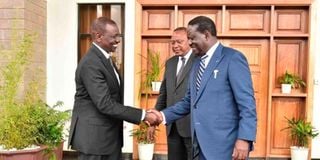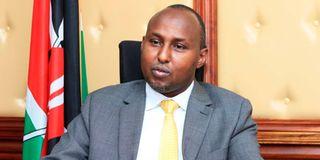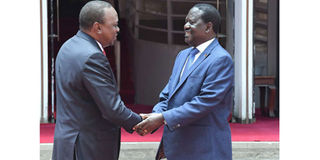‘Ruto offered Raila half of government to kick out Uhuru’

President Uhuru Kenyatta looks on as Deputy President William Ruto and ODM leader Raila Odinga shake hands during a past meeting at the DP’s residence. Photo | Pool
Deputy President William Ruto offered Mr Raila Odinga and his ODM associates half of all senior government positions in return for helping the DP topple President Kenyatta soon after the 2017 elections, a key confidante of Mr Odinga has revealed to the Nation in an interview that could dramatically escalate the hostility between Mr Kenyatta and Mr Ruto.
Mr Junet Mohamed, also the national coordinator for the Azimio La Umoja coalition, says in the interview that he was part of the team discussing the impeachment proposals with DP Ruto.
He adds that Mr Odinga was offered the position of Deputy President in the talks, with Ruto assuming leadership of the country in a post-Kenyatta era in 2018.
His dramatic revelations come a day after Mr Odinga denied claims by the DP that he schemed the ouster of President Kenyatta.
Mr Mohamed says the ouster plot, which he claims was mooted by the DP, would have seen the President hounded out of office just days into his second term.
The Constitution provides that the Deputy President takes over as President for the remainder of a term should the incumbent be removed from office.
Mr Mohamed claims Mr Ruto reached out to them to help neutralise Mr Kenyatta, whom he felt was already showing signs of betraying him. The plot began immediately the President was re-elected in 2017, but was abruptly slowed down by the voiding of his victory by the Supreme Court on the grounds that the Independent Electoral and Boundaries Commission had not complied with the constitution while presiding over the polls.
ALSO READ: Why August poll is a Uhuru vs Ruto affair
“The President hosted a Jubilee parliamentary group meeting at State House soon after he was declared the winner. In that meeting, it became clear that the honeymoon with his deputy was over. Mr Kenyatta told his party’s rank and file that he would not share power with anyone. The remarks alarmed his deputy as it meant it would not be business as usual,” Mr Mohamed said.
The second election
The President, however, had to put on ice his plan to secure his helm soon after the Supreme Court ruling, as it meant he had to work with Dr Ruto and the battalion of MPs both had built in the elections to win in the second round battle with Mr Odinga, which the ODM leader boycotted.
Mr Mohamed claims that Mr Ruto’s overtures came soon after that second election. According to him, the Deputy President was uneasy with the way the President had outlined the terms of engagement for his final five years in office. What he does not explain well, however, is why Mr Odinga opted not to take the offer after a series of meetings.
“The deal was too enticing to us but we had to weigh it carefully,” he says. “Why would we settle for the Number Two slot when our party leader was himself more qualified for the top job?”
President Kenyatta kicked up a storm last Saturday when he reportedly told some 3,000 elders and elected leaders from Mt Kenya that his principal assistant had planned to snatch power from him.
The Head of State was explaining the genesis of his fallout with Mr Ruto and how the handshake, the political truce with his main challenger in the 2017 General Election, had come about.
His remarks drew an instant and strong rebuttal from Mr Ruto, who said a day later: “I am not a fool, a drunkard or a mad man to help put together a government and then go behind it and plan to topple it. As Deputy President, I know what I must do, and I will never, I have never, and it has never happened that I will do anything to bring down our government. To those spreading the propaganda, shame on you! Shame! You deserve nothing but shame.”

Suna East MP Junet Mohamed during an August 2020 interview. The MP, a close confidante of Mr Odinga has said DP Ruto approached ODM asking for the party’s support to impeach President Kenyatta, a claim the DP has strongly denied.
The meetings
Mr Ruto accused the President of engaging in propaganda in an attempt to poison his central Kenya backyard against his State House ambition.
On that note, he told his boss: “We forgive you, but do not spread lies about us and do not make other people spread propaganda for no reason. We are peaceful, straightforward, and law-abiding people who believe in the constitution.”
But Mr Mohamed, in an exclusive interview with the Nation, says there, indeed, had been talks to impeach the President, and that a prominent Rift Valley businessman who had lost out on lucrative government tenders—which he blamed on some people in the President’s inner circle —facilitated the meetings, which took place in a private residence in the Karen neighbourhood of Nairobi.
Mr Odinga’s ODM was charged with mobilising at least 100 lawmakers in the Senate and National Assembly to boost the numbers the DP would contribute from Jubilee and other fringe parties to make 234, the constitutional threshold to kick out President Kenyatta.
For the scheme to appear as an opposition agenda, Mr Mohamed says, their party was to move the impeachment motion in Parliament, and that MPs would have been bribed between Sh300,000 and Sh500,000 to vote in favour of the motion.
“We did not commit to the plan immediately, but retreated to interrogate the proposal first,” says Mr Mohamed. “The overriding thinking was that we were just smarting from a gruelling election and this was not in our best interest, and Mr Odinga felt that route was a sure way of taking the country back to the drain again.”
He adds that the government, through its intelligence machinery, got wind of the back-and-forth meetings and started acting on them.
“A senior and powerful minister from Nyanza called me with a stern warning. He asked why we wanted to take the country down the hill, why we wanted to destroy the country. It got us thinking, because with the government already in the picture, we needed to be careful on our moves. That’s when Raila chose to tell Uhuru the full extent of the plan,” Mr Mohamed says.
According to him, active engagements between Mr Odinga and Mr Ruto started in January 2018 after the DP and his allies started grumbling that the President was excluding them from his new Cabinet.
In a marked departure from 2013, when the two were present at the unveiling of their new Cabinet, in January 2018, Mr Kenyatta had announced his second Cabinet without the bonhomie displayed five years earlier.
The first meeting to plot the impeachment took place on January 12, 2018, about a week after the President announced partial Cabinet appointments. It took place at the Karen home of the tycoon from Rift Valley, who remains unnamed.

President Kenyatta and Mr Odinga’s handshake in 2018, after the disputed 2017 presidential vote.
While the DP has, in the past, acknowledged contact with Mr Odinga after the 2017 elections, his version of events is different from that of Mr Mohamed.
Approaching Raila
In an April 2019 interview with Citizen Television, he admitted to Mr Hussein Mohammed, the former journalist who now runs his presidential election communication secretariat, that he had contact with the ODM leader at least four times during the standoff over the 2017 presidential election.
“Before Raila Odinga engaged the President on the matter of the handshake, he engaged me,” said the Deputy President.
“He approached me on four occasions after the election to have a discussion but I declined to engage with him for two reasons: One, in Jubilee we have one central command; President Uhuru Kenyatta is the party leader and president and we all defer to him. If there is any engagement with anybody on matters politics, it has to start with President Uhuru Kenyatta.
“For your information, for every approach that was made by Raila Odinga to me, I informed the President. I told him I will not engage Raila Odinga. The second reason is, I did not believe that he was doing this in good faith.”
ALSO READ:Uhuruto never worked together for a day
The DP said he only learnt the ODM side wanted to rock the Jubilee government in subsequent conversations with Mr Odinga.
“On two occasions we actually spoke on the phone when he sent some emissary. And I could hear the trend, you know.... ‘You can see the President has already started to appoint ministers’. You remember when the President appointed the first six ministers and there was hullabaloo there.
I told him initially we were running a coalition but today we have a party, and the President is the head of that party. He doesn’t have to consult me. I could see where the thing was going, to try and say [I’m] being short-changed and that kind of narrative, which to me is fake. So I did not engage him.”
He went on: “So finally when the engagement was carried out under this handshake story, it was not necessary for President Kenyatta to let me know. But being the gentleman that he is, he actually brought me on board. He told me, ‘Mr Deputy President, I am having an engagement with the leader of the opposition’. And I gave my views,” Mr Ruto said in the interview that President Kenyatta already knew that Mr Odinga was courting him.
Stopping ‘ruthless’ Kenyatta
Days before the explosive 2019 parliamentary group meeting at State House, then Jubilee Party vice-chairman David Murathe had warned that the President would be ruthless, brutal and lethal in his second term in office. That statement, according to Mr Mohamed, had not gone down well in the DP’s wing of government.
Mr Mohamed argues that the DP’s talks with Raila were meant to stop the new, ruthless Kenyatta in his tracks, especially on his plans to rule by fiat in his second and last term in office. To the Ruto camp, this was a co-presidency, and the President needed to treat it as such.
Article 145 of the Constitution stipulates that a sitting Head of State can be kicked out on the grounds of gross violation of the supreme laws, or where he or she is suspected to have engaged in criminal activities, among others.
In this instance, Mr Mohamed said, the plan was to cite Mr Kenyatta for disobeying court of orders, and in other instances, he was accused to have been in violation of the Constitution.
Kenya’s bicameral Parliament needs at least two-thirds of its membership to support such a motion to sail through. Within seven days after receiving notice of a resolution from the Speaker of the National Assembly, the Speaker of the Senate needs to call a meeting of the Senate to hear the charges, and if at least two-thirds of all the members of the Senate vote to uphold any impeachment charge, the President ceases to hold office.
Under such circumstances, the Deputy President would assume office as President for the remainder of the term of the President.
Mr Mohamed used an analogy of a butcher who shows a bull a sharpened knife that will soon be used to slaughter it and still expects a smile from the animal to explain the bad blood between the President and DP.
“You don’t make known such a sinister motive and fail to execute,” he said. “The same sword would certainly be used on your neck. You’ve been around and know what I’m talking about. The world is that brutal.”
Mr Mohamed was the closest politician to the former Prime Minister at a time when only a clique knew the details of the Handshake. He’s even understood to have run errands on Mr Odinga’s behalf at a time most senior ODM members were either in the dark of the détente or sceptical of it.
The “Armageddon”
A master political tactician, Mr Odinga opted to exploit this to his advantage, according to Mr Mohamed. The ODM leader approached the President to warn him of the “Armageddon” that awaited him should Mr Ruto have his way, and the two, who had fought hammer and tongs at the elections, crafted a united front against the DP. The President has since endorsed Mr Odinga’s State House bid.
Insiders say Mr Odinga saw a perfect opportunity to fix Mr Ruto, whom he never forgave for abandoning him to team up with Mr Kenyatta in the 2013 presidential polls, denying him victory.
Some in the corridors of power are of the view that whatever made the President and his deputy, once fondly referred to as ‘The Dynamic Duo’, part ways must have been profound and personal, especially after attempts by a section of the clergy to reconcile them hit a snag.
The President is said to have told the prelates, without giving reasons, that only God can make him forgive his deputy for the “sins” he committed.





